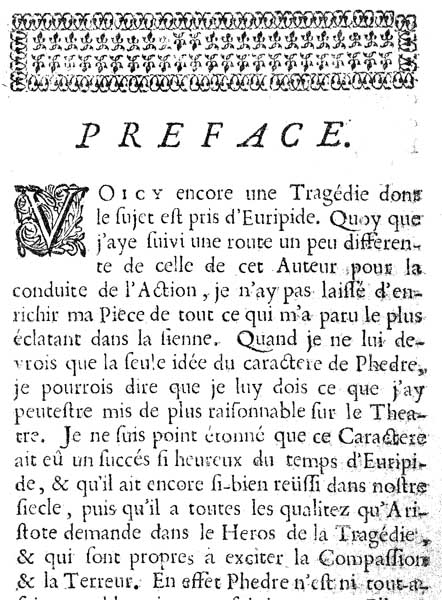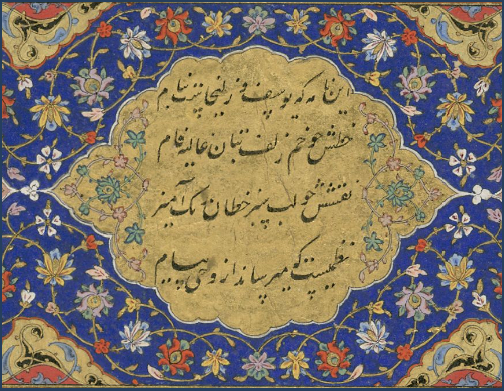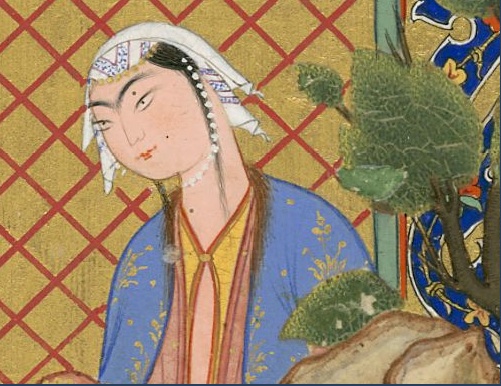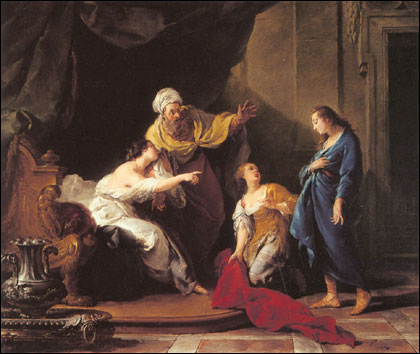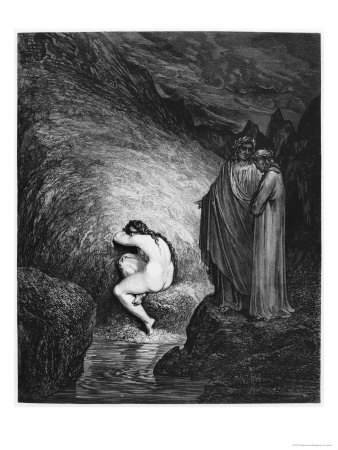April 24, 2009
Alexandrine in Five Times
New Yorker movie critic Pauline Kael had this to say about the 1968 film version of Phèdre:
Marie Bell has been acclaimed as the greatest Phèdre since Bernhardt. Most Americans must take this judgment on faith, but at least it's possible to see her legendary performance and to glean an idea of the sound and look of the classic French style of acting from this somewhat shortened version of the Racine tragedy in Alexandrine verse, directed by Pierre Jourdan.
This clip, which begins with a vertiginous over-the-shoulder shot ("one of those ladder-high positions from which birds and movie cameras view the world" - Vincent Canby, New York Times), features Claude Giraud (Hippolyte), Tania Torrens (Aricie) and Jean Chevrier (Théramène).
It's a shame this clip doesn't have the English subtitles it did on the grainy VHS I watched last night. William Packard's 1966 translation went full-monty with the twelve-syllable rhyming couplets -- an "incredibly difficult undertaking" for an anglophone:
It is not as if the alexandrine line had never been used in English literature; it has, and sometimes to great effect. But it is not in our pulse, the way Shakespeare's blank verse line is in our pulse. Just as the Italians have their terza rima, and the Japanese have their 17-syllable haiku, so the French have their alexandrine and the English have their pentameter; it is the unique expression of a civilization, and it cannot really be accounted for.
Tim Chilcott, undaunted, gives it a shot:
Three hundred or so years after Jean Racine's death in 1699, the best reason for offering a new translation of his work may also seem the most ironic: that his plays continue to appear untranslatable....Racine's plays are famously written in alexandrines, twelve-syllable lines that were first used in the late twelfth-century epic Le Roman d'Alexandre, and that later became the standard metrical form for French neo-classical tragedy....
Although two recent translations (by C.H. Sisson and Robert David MacDonald) have sought to reproduce this expansiveness (with an eleven-syllable and a hexameter line, respectively), few versions have followed the example. Pope's well-known comment continues to bite ('A needless Alexandrine ends the song, / That, like a wounded snake, drags its slow length along').
The weight and ponderousness of the metre in English are a substantial disadvantage, evoking as they do a stately largo di molto rather than any more vibrant pulse. As a result, this translation adopts an iambic pentameter line.
Robert David MacDonald spikes the ball back into the other court:
On looking at the two most distinguished of the translations currently available, by poets a generation apart, both of considerable technical achievement, I found them veering dizzily between the wilfully paraphrased and the vapidly cute....Part of the trouble seemed to lie in the adoption of the rhymed five-foot heroic couplet, making everything sound like a succession of final distichs in some Shakespearean forgery. I have therefore preserved the Alexandrine hexameter.
"Le dessein en est pris, je pars, cher Théramène" - to director Jean-Louis Barrault, the opening line of Phèdre "matched the rhythms of Hippolyte's footsteps, ensuring that he was in position on the word 'Théramène'." Susan Bassnett's Translation Studies gives three different English takes on the same line:
I have resolved, Theramenes, to go. (John Cairncross)No, no, my friend, we're off. (Robert Lowell)
No! No! I can't. I can't. How can I stay? (Tony Harrison)
(Phaedra Britannica, by Harrison "after Jean Racine," not only translates the language, but moves the action to the British Raj in 19th-century India.)
Here are a few others:
I have made up my mind: I go, dear Théramène. (William Packard)I am resolved to leave this place, Theramenes. (Robert David MacDonald)
I have made my decision. (Ted Hughes)
Hungry for more? Check out Colin John Holcombe for a feature-length translator cage match.
Some 35 years after the video above, Patrice Chéreau directed Phèdre at the Ateliers Berthier, Théâtre de l'Odéon, in 2003 (here are the teacher's notes, in French). The production was filmed by Stéphane Metge for ARTE France (here's a DVD press release, also in French).
This clip from the same scene features Marina Hands (Aricie), Éric Ruf (Hippolyte) and Michel Duchaussoy (Théramène).
And for dessert, here's The Divine Sarah as Phèdre (act 2, scene 5) on a scratchy Pathé cylinder recorded over one hundred years ago.
April 22, 2009
Shock Absorbers
The New York Review of Books piece on Grief Lessons: Four Plays by Euripides links to the full text of translator Anne Carson's preface to Hippolytos.
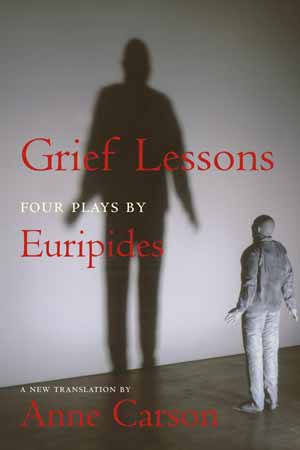
Too bad it doesn't also include the book's intriguing final essay, "Why I Wrote Two Plays About Phaidra". In a first-page footnote, Carson explains that piece's backstory:
The Athenian tragedian Euripides (c. 484 - c. 406 BC) appears to have made two attempts to compose a tragedy on the myth of Phaidra and her disastrous infatuation with her stepson Hippolytos. We have one complete tragedy called Hippolytos (produced 428 BC) and some fragments of an earlier version called Hippolytos Veiled (date of production uncertain).The earlier production was a flop. It seems to have offended audiences by portraying Phaidra as a bold sexual predator who confronts Hippolytos directly with her desire. The later version reimagines Phaidra and her virtue: she agonizes about keeping her lust a secret; is shocked to find her feelings betrayed to Hippolytos by an old Nurse; recoils from addressing the young man face-to-face; overhears him saying bad things about her and hangs herself offstage.
In the essay, Carson imagines Euripides addressing his audience directly as he chews over the first version's failure:
I don't understand, I could never have predicted, your hatred of this woman. It's true she fell in love with someone wrong for her but half the heroines of your literature do that, Helen, Echo, Io, Agave, all of them. Phaidra's love was for her stepson, and it excited you badly, maybe not the incest so much as a question of property rights - ditch the old man, marry the son, keep the estate. Truth is often, in some degree, economic. Which isn't to say her passion for Hippolytos was fake. Women learn to veil things. Who likes to look straight at real passion? Looks can kill. I would call "feminine" this talent for veiling a truth in a truth.Euripides had to do a little veiling of his own to win his audience back. Refract those killer looks through a periscope, or one of those convex mirrors that give you a preview of what's lurking around a dangerous subway corner.
You didn't like Phaidra so I started over. Wrote another play, it took years. Called this one Hippolytos, no veil. To get rid of the veil I had to pull shame out of the inside of Phaidra and spread it on all her surfaces, on all the surfaces of the play, like a single hurt color. Shame is many things. In Hippolytos, shame is what the boy worships as a goddess in the form of Artemis, a pure uncut watergreen shame that reminds him of his own virginity. Shame is also the blush that dyes Phaidra so hot she cannot live in the same body with it. Odd that this virtue, also a vice, is one they share without seeing how."Shame lives on the eyelids" according to an old Greek proverb. I guess this means it makes you cast your eyes down, or that it blinds you. Both Phaidra and Hippolytos act in a blindness as they grapple, deflect and slide past one another into death. There is no moment of confrontation or truth between the two. They never exchange a touch, word or glance. Shame segregates them so effectively, they live and die within earshot of one another, out of reach on the same stage. Pathos like that could win me first prize this time, don't you think?
Jean Racine, in his 1677 preface to Phèdre, describes the nips and tucks he made to fit the story to his own era's moral squeamishness:
I am not surprised that the character enjoyed such immense success in Euripides' day, or that it still succeeds so hugely in our own century, since Phedra has all the qualities Aristotle required of the tragic hero - qualities apt to excite pity and terror....
I have even been careful to make her a little less odious than she is in the tragedies of the Ancients, where she herself resolves to accuse Hippolytus. I felt calumny was a little too base and too black to put it in the mouth of a princess, one who, moreover, has such noble and virtuous feelings.
This baseness seemed more appropriate to a nurse who might have more of a slave's inclinations and yet who still only resorts to the false accusation to save her mistress's life and honour. Phedra goes along with it only because she is beside herself with mental turmoil....
In Euripides and Seneca, Hippolytus is accused of having actually raped his step-mother: vim corpus tulit ['My body has suffered his violence']. But here he is only accused of having intended to. I wanted to spare Theseus a vehemence that might have made him less acceptable to the audience.
As for Hippolytus as a character, I noticed with the Ancients that Euripides was attacked for having represented him as a philosopher-prince exempt from all imperfection - which meant the young man's death caused more indignation than pity. I felt I should give him some flaw that would make him slightly culpable in relation to his father without, however, detracting in any way from the greatness of soul whereby he preserves Phedra's honour and allows himself to be condemned without accusing her. I call a flaw the passion he feels in spite of himself for Aricia, who is the daughter and sister of mortal enemies of his father.
But the theatregoers of 17th-century Paris weren't the only ones reading over Racine's shoulder. Orphaned at two, he got his education from the Jansenists, who probably would've shut down the theatres like their Puritan neighbours across the Channel if they hadn't got themselves sent to the woodshed for heresy. Racine's former teacher Pierre Nicole published a public letter accusing novelists or playwrights of having no more redeeming virtues than a "public poisoner", so it's no wonder Racine concluded his preface with what might today be described as a little preemptive ass-covering:
What I can say is that I have never written a tragedy where virtue is made more abundantly clear as in this one. The smallest sins are severely punished. The mere thought of a criminal act is regarded with as much horror as the act itself. The weaknesses engendered by love are shown for what they are: real weaknesses.Passions are only paraded before our eyes in order to show all the chaos they cause; and vice is here depicted everywhere in colours that lead to understanding of and hatred for its moral ugliness. This is properly speaking the goal which any man who works for the public should set himself; and it is what was uppermost in the minds of the original poet-tragedians....
It is earnestly to be hoped that our works prove as solid and as full of useful instruction as those of these poets. This would perhaps provide a means for reconciling tragedy to a great many persons celebrated for their piety and their knowledge who have in recent times condemned it and who would no doubt judge it more favourably if authors thought as much of instructing their audience as of entertaining them - following thereby tragedy's real intention.
Anne Carson's Euripides isn't quite so sure about this "intention". She envisions him, if not kicking and screaming, at least muttering resentfully about the corset he had to cinch around his original heroine:
In general I like women. I like glossing around in women's language, so different from men's. But this one seized me as no other character ever had - that first Phaidra, the pure chainsmoking nihilism of her, pacing the cage of her own clarity. What rushed through her speech wasn't fuss about mirrors and chastity. Only a fool would have asked her for a moral position. Her people feared her. Her own spirit feared her. You feared her.So, Phaidra - a work in motion, surpassing her, surpassing itself - disappears again and again into Phaidra after Phaidra, but she is not gone, her disappearance in fact reverberates everywhere in this so-called second version. I wrote it to show how that feels. Phaidraless world. Her great soul withdrawn, the story goes through its tricks in a weak voltage of vicious reactions and bad piety, which I hope will amuse you but this fact remains, there is no shock in it anywhere except Aphrodite.
Aphrodite is pure shock. When she comes onstage in the prologue and tells you about a few simple stitches she is going to take in the lives of Phaidra, Hippolytos and Theseus, you feel the salt of absolute cruelty sting your face.
And what about now? Sarah Kane's Phaedra's Love (1996), a reimagining of the myth after Seneca, pumps up the volume, bringing graphic violence and sex onstage. British theatregoers haven't had an official shock absorber since the Lord Chamberlain's Office stopped censoring plays in 1968. These days it's more or less up to us to decide how much we can take. How much salt are we willing to swallow?

Anne Carson points out that Hippolytos's name means "loosed by horses".
"Loosed" in the sense "unbound, unfastened, undone" and also "dissolved, destroyed, pulled apart" and also "opened, released, set free" and also "atoned for, paid off, made good." Aphrodite's justice requires that the man who refused the yoke of marriage should be dragged to death by the yoke of his own horses.
Are audience opinion and social morality a yoke? Or does too much freedom undo us?
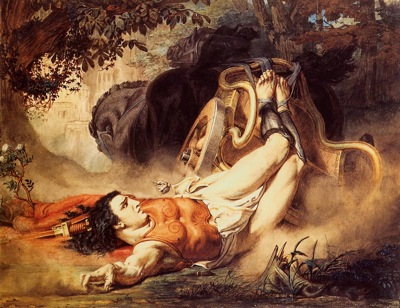
April 19, 2009
When Love Gives You Lemons
When the Qur'an describes something as "the most beautiful of stories," it's worth checking out. (And, really, what doesn't look more gorgeous calligraphed in Arabic?)
The Biblical Joseph and Potiphar's wife become Yusuf and Zulaikha in the Qur'an. The story was most famously explored by the Sufi poet Jami in the Haft Awrang ("Seven Thrones"), written in Persian sometime around 1480.
The Turkish-French writer Elif Shafak believes that "In the history of Islam, perhaps no woman has been as widely (mis)interpreted as Zulaikha... a despicable symbol of lust, hedonism, and, ultimately, feminine evil." However,
As wicked as Zulaikha might be in the eyes of the conservative Muslims, she was considered in a completely different way by the Sufis. For the Sufi mystic, Zulaikha simply represented someone purely and madly in love. Nothing more and nothing less....For the [Sufi] dervish, as Ibn Arabi stated, there was no religion more sublime than the religion of love. The Islamic mystic would "follow the religion of Love, whichever way his camels take."
In a lecture titled "Spiritual Liberty", given in London in 1914, the Sufi teacher Hazrat Inayat Khan said, "from the story of Yusuf and Zulaikha we learn what part beauty plays in the world of love."
Yusuf was so beautiful that Zulaikha, the wife of his master (interesting how in this lecture Zulaikha's husband, "the Aziz" or "the chief", is the one who goes nameless, in contrast with Potiphar's wife), "raised him in her eyes from a slave to a king," saying, "Those crowned with beauty are always kings, even if they are in rags or sold as slaves."
As the growing gossip of her friends and relations "eventually put Zulaikha in a difficult position," she
invited all her relations and friends, and put into the hands of each of them a lemon and a knife, and told them all to cut the lemons when she should tell them, and then called Yusuf.When he came she told them to cut the lemons, but the eyes of everyone among them were so attracted by the appearance of Yusuf, that many instead of cutting the lemon cut their fingers, thereby stamping on their fingers also the love of Yusuf.
'Beauty takes away from the lover the consciousness of self.'
In this version, it seems, it's not the sexual advances that offend Yusuf so much as the Egyptian woman's religious faux pas:
When the shadow of passion fell upon the soul of Yusuf, Zulaikha happened to think of covering the face of the idol, which was in her room. This astonished Yusuf and made him ask her, 'What doest thou?' She said, 'I cover the face of my god that seeth us with his eyes full of wrath.'This startled Yusuf.... 'Stay, O Zulaikha, of what hast thou put me in mind! The eyes of thy god can be covered with a piece of cloth, but the eyes of my God cannot be covered. He seeth me wherever I am.'...
Zulaikha, blinded by the overwhelming darkness of passion, would not desist, and when he still refused, her passion turned into wrath. She hated him and cursed him and reminded him of his low position as a slave. On this he began to leave the room.
From here the story pretty much parallels Genesis, with the false accusation and the angry husband and the prison and all. But in a happy ending that Nahum Tate would envy, years later, having interpreted Pharaoh's dream and become "chief over all his treasures,"
Yusuf, riding with his retinue, happened to pass by the place where [the now widowed] Zulaikha in her utter misery was spending her days.On hearing the sound of horses' hoofs many people ran to see the company passing, and all called out, 'It is Yusuf, Yusuf!' On hearing this, Zulaikha desired to look at him once again. When Yusuf saw her he did not recognize her, but he halted, seeing that some woman wished to speak with him.
He was moved to see a person in such misery, and asked her, 'What desirest thou of me?' She said, 'Zulaikha has still the same desire, O Yusuf, and it will continue here and in the hereafter. I have desired thee, and thee alone I will desire.'
Yusuf became very convinced of her constant love, and was moved by her state of misery. He kissed her on the forehead, and took her in his arms and prayed to God. The prayer of the prophet and the appeal of long-continued love attracted the blessing of God, and Zulaikha regained her youth and beauty.
Yusuf said to Zulaikha, 'From this day thou becomest my beloved queen.' They were then married and lived in happiness.
'Verily God hearkens attentively to the cry of every wretched heart.'
The Smithsonian has a sumptuous online feature on their manuscript of Jami's "Seven Thrones". Click through to find "Yusuf and Zulaykha", and don't forget that on the navigation arrows, "Next" turns the Arabic text's pages right-to-left (the first time, I read it backwards).
An unhappy footnote to this story is the fate of Hazrat Inayat Khan's daughter, Noor-un-Nisa Inayat Khan. Years after her father's death, her family fled Paris when the Germans invaded in 1940. Noor became a British Special Operations Executive agent and, under the code name "Madeleine", the first woman operator to be infiltrated into Nazi-occupied France.
In his lecture, Hazrat Inayat Khan noted that Yusuf
was thrown into a well by his elder brothers, who were jealous of his beauty and the influence that it had on their father and everyone that met him.'Not love alone, but beauty also has to pay its forfeit.'
Noor Inayat Khan was eventually imprisoned and executed after being betrayed to the Gestapo, in one theory, by Renée Garry, the sister of her network organizer. The story goes that Garry, despite being paid 100,000 francs, acted mainly out of jealousy, believing she had lost the affections of SOE agent France Antelme to Noor.
So: Hippolytus loves, but loves not me....
I will not tolerate their happiness.
April 17, 2009
Hell Hath No Fury like Potiphar's Wife
And Joseph was brought down to Egypt; and Potiphar, an officer of Pharaoh, captain of the guard, an Egyptian, bought him....And Joseph was a goodly person, and well-favored. And it came to pass after these things, that his master's wife cast her eyes upon Joseph; and she said, Lie with me. But he refused....
And it came to pass, when she saw that he had left his garment in her hand, and was fled forth, that she called unto the men of her house, and spake unto them, saying, See, he hath brought in a Hebrew unto us to mock us; he came in unto me to lie with me, and I cried with a loud voice....
When his master heard the words of his wife, which she spake unto him, saying, After this manner did thy servant to me; that his wrath was kindled. And Joseph's master took him, and put him into the prison.
Potiphar's wife goes nameless in the Bible, but a medieval commentary on the Torah calls her Zuleika:
Against the Biblical narrator's terse and suggestive account, Sefer Hayyashar [1625 AD] paints a vivid portrait of an woman pathologically obsessed with Joseph's physical beauty. She continually urges Joseph on, whether by enticement, threats or trickery, and her passion ultimately brings upon her a suicidal state of physical depression....The name 'Zuleika' also seems to emanate from an Islamic source. Epic poems on this theme circulated widely in medieval times, of which the most popular was Yusuf and Zulaikha, composed in 7000 Persian couplets by the fifteenth-century poet Jami. The author was a Sufi who regarded the story of Joseph's temptations as an allegory for the mystical striving after divinity.
Dante stumbles across this character in the frozen fraud section of Hell (eighth floor, aisle 10, Perjury - if you hit Counterfeiting you've gone too far):
"Who are the two poor wretches
That smoke like unto a wet hand in winter...?""One the false woman is who accused Joseph,
The other the false Sinon, Greek of Troy;
From acute fever they send forth such reek."[The Divine Comedy: Inferno, Canto XXX (c. 1300 AD)]
Coincidentally, the earliest known mention of Phedre is in Homer's account of Odysseus's visit to the underworld:
When I had prayed sufficiently to the dead, I cut the throats of the two sheep and let the blood run into the trench, whereon the ghosts came trooping up from Erebus - brides, young bachelors, old men worn out with toil, maids who had been crossed in love, and brave men who had been killed in battle, with their armour still smirched with blood; they came from every quarter and flitted round the trench with a strange kind of screaming sound that made me turn pale with fear....Anon Proserpine sent up the ghosts of the wives and daughters of all the most famous men. They gathered in crowds about the blood, and I considered how I might question them severally.... Then I saw Phaedra, and Procris, and fair Ariadne daughter of the magician Minos, whom Theseus was carrying off from Crete to Athens, but he did not enjoy her, for before he could do so Diana killed her in the island of Dia on account of what Bacchus had said against her.
[The Odyssey, Book XI (c. 800 BC)]
Not to be outdone, Virgil gives Aeneas a similar encounter in Hades:
Not far from thence, the Mournful Fields appear,
So call'd from lovers that inhabit there.
The souls whom that unhappy flame invades,
In secret solitude and myrtle shades
Make endless moans, and, pining with desire,
Lament too late their unextinguish'd fire.Here Procris, Eriphyle here he found,
Baring her breast, yet bleeding with the wound
Made by her son. He saw Pasiphae there,
With Phaedra's ghost, a foul incestuous pair.[The Aeneid Book VI (c. 20 BC)]
So as it turns out, Hell hath a fury like not one but two scorned women after all.
---
April 12, 2009
Dramaturgy Part 1: Jean Racine (1639-1699)
(This is part 1 of a package of dramaturgical material for Phèdre, adapted in part from the Encyclopedia Britannica.)
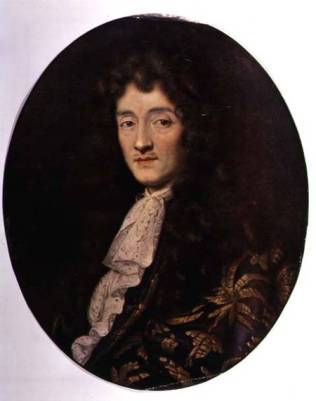
Jean Racine was born into a provincial family of minor administrators. His mother died 13 months after he was born, and his father died two years later. His paternal grandparents took him in, and when his grandmother, Marie des Moulins, became a widow, she brought Racine, then age nine, with her to the convent of Port-Royal des Champs near Paris.
Since a group of devout scholars and teachers had founded a school there, Racine had the opportunity – rare for an orphan of modest social origins – to study the classics of Latin and Greek literature with distinguished masters. The school was steeped in the austere Roman Catholic reform movement known as Jansenism, which had recently been condemned by the church as heretical.
Since the French monarchy suspected the Jansenists of being theologically and politically subversive, Racine’s lifelong relationship with his former friends and teachers remained ambivalent, inasmuch as the ambitious artist sought admittance into the secular realm of court society.
Racine spent the years from 1649 to 1653 at Port-Royal, transferred to the College of Beauvais for almost two years, and then returned to Port-Royal in October 1655 to perfect his studies in rhetoric. When he was 18 the Jansenists sent him to study law at the College of Harcourt in Paris.
Racine’s first play, Amasie, was never produced and has not survived. His career as a dramatist began with the production by Molière’s troupe of his play La Thébaïde ou les frères ennemis (“The Thebaide or the Enemy Brothers”) at the Palais-Royal Theatre on June 20, 1664. Molière’s troupe also produced Racine’s next play, Alexandre le grand (Alexander the Great), which premièred at the Palais Royal on December 4, 1665.
This play was so well received that Racine secretly negotiated with the Hôtel de Bourgogne – a rival troupe that was more skilled in performing tragedy – to present a “second première” of Alexandre on December 15. From this point onward all of Racine’s secular tragedies would be presented by the actors of the Hôtel de Bourgogne.
Racine followed up his first masterpiece, Andromaque (1667), with the comedy Les Plaideurs (1668; The Litigants) before returning to tragedy with two plays set in imperial Rome, Britannicus (1669) and Bérénice (1670). He situated Bajazet (1672) in nearly contemporary Turkish history and depicted a famous enemy of Rome in Mithridate (1673) before returning to Greek mythology in Iphigénie en Aulide (1674; Iphigenia in Aulis) and the play that was his crowning achievement, Phèdre (1677).
By this time Racine had achieved remarkable success both in the theatre and through it. Racine was the first French author to live principally on the income provided by his writings.
Within several months of the appearance of Phèdre, Racine married the pious and unintellectual Catherine de Romanet, with whom he would have two sons and five daughters. At about the same time, he retired from the commercial theatre and accepted the coveted post of royal historiographer with his friend Nicolas Boileau.
As one of the royal historiographers, Racine chronicled Louis XIV’s military campaigns in suitable prose. Racine’s official duties culminated in the Eloge historique du Roi sur ses conquêtes (1682; “The Historical Panegyric for the King on His Conquests”). He also wrote the Cantiques spirituels (1694) and worked hard to establish his status and his fortune.
In 1672 he was elected to the French Academy, and he came to exert almost dictatorial powers over it. In 1674 he acquired the noble title of treasurer of France, and he eventually obtained the higher distinctions of ordinary gentleman of the king (1690) and secretary of the king (1696).
In response to requests from Louis XIV’s consort Madame de Maintenon, Racine returned to the theatre to write two religious plays for the convent girls at Saint-Cyr: Esther (1689) and Athalie (1691). His other undertakings during his last years were to re-edit, in 1687 and finally in 1697, the edition of his complete works that he had first published in 1676, and to compose, probably as his last work, the Abrégé de l’histoire de Port-Royal (“Short History of Port-Royal”).
Racine died in 1699 from cancer of the liver. In a codicil to his will, he expressed his wish to be buried at Port-Royal. When Louis XIV had Port-Royal razed in 1710, Racine’s remains were transferred to a tomb in the Parisian church of Saint-Étienne-du-Mont.
Adapted from www.britannica.com/EBchecked/topic/488151/Jean-Racine
Dramaturgy Part 2: Jansenism
(This is part 2 of a package of dramaturgical material for Phèdre, written, collected and edited by Megan Cohen and Michael Paller of the American Conservatory Theater.)
Racine was orphaned in his early childhood and brought up in the Jansenist Port-Royal, an abbey in Versailles devoted to a controversial sect of Christianity. The Jansenists had a pessimistic vision of human nature, emphasizing original sin, and saw people, according to scholar Philip Lewis, as "ravaged by egocentric lust."
In the landscape of 17th Century French Catholicism, Jansenism was a stern reform movement, which splintered off in opposition to the Jesuits' doctrinal compromises and devout humanism. In The Classical Moment, scholar Martin Turnell describes the differences:
The teaching of the Jesuits laid great stress on the importance of free will, on the co-operation of the human will with Divine grace in the work of the Redemption. Man had fallen, but his nature was not completely ruined by the Fall, for his sin had been redeemed by the sacrifice of Christ.This was in essence a Christian optimism. It encouraged men to hope and to place confidence in their own actions… this view encouraged corporate worship and curbed the vagaries of religious experience. It stood for authority and discipline; it was essentially a reasonable, moderate outlook.
The most important aspect of Jansenism was its view of grace and original sin… in practice it approximated to the Lutheran belief that man's nature had been completely ruined by the Fall… Jansenism emphasized man's isolation and minimized the normative influence of the Christian society.
It was in essentials a pessimistic doctrine which placed man at the mercy of his passions and this accounts for the streak of fatalism which runs all through Racine's poetry. It was also a highly introspective religion, and whatever the intentions of Jansenist theologians, it undoubtedly exalted the importance of the individual conscience at the expense of external authority.
In the Jansenist view, those who are not lucky enough to be chosen for salvation are damned, regardless of their personal intent. This led Nancy Mitford to describe the Jansenists in The Sun King (her history of Louis XIV's reign) as "a gloomy sect" in comparison to the Jesuits, who she names "supple, adroit men of the world."
Despite their despairing view of mankind, the Jansenists were not entirely without hope. They sought a balance between the Roman Catholic belief in individual free will and the Calvinist notion of total predestination, seeing salvation as something that required choice and pursuit in addition to supernatural determinism. To attain deliverance, the lucky chosen ones must take individual action to follow a righteous path.
The followers of Jansenism were primarily educated, often upwardly mobile, and part of the movement's appeal lay in this focus on individual conscience and freedom of thought, as opposed to placing faith in an absolutist power. The Jansenists described God as both absent and present: elusive, but knowable through faith, helping those who are both destined to find grace and actively choose to seek him out.
Racine disagreed with Jansenist leaders on the function of literature. While the chief spokesmen of the movement advocated distance from the sphere of arts and letters and from polite secular culture, seeing such worldly pursuits as wicked and impious, Racine made his career penning tragedies where the social concerns and pagan cosmologies were far from the strict values of Jansenism.
However, Phèdre, his last secular play, marked a change in his opinions: in his Preface to the work, he describes the piece as morally valuable, and worthy of attention and approval from his Jansenist friends and colleagues.
In A New History of French Literature (1994), Lewis illustrates the Jansenist underpinnings of Phèdre:
"Phèdre, the last and most deeply passionate heroine of Racine's secular tragedies, plays out the possibility that victims of the Fall - even those striving to be just - could be doomed to die, without grace, in unremitted sin.However, the farthest-reaching Jansenist motif in Phèdre lies not in the deeply tragic heroine's tortured conscience, but in the play's anguished revelation, communicated to Theseus by both Phèdre and Hippolyte, of a receding divinity - emblematized by the defeated sea monster - that will not reappear, that will remain concealed and ineffable.
Dramaturgy Part 3: Sexual Protocol in Racine's World
(This is part 3 of a package of dramaturgical material for Phèdre, written, collected and edited by Megan Cohen and Michael Paller of the American Conservatory Theater.)
Adapted in part from A History of Sexual Customs by Richard Lewinsohn and Louis XIV: a Royal Life by Olivier Bernier.
The playwright's take on infidelity in Phèdre rebuked the decadence of Louis XIV's court, and signaled the playwright's movement towards reconciliation with the Jansenist values of his upbringing.
Although earlier in his career Racine had several liaisons with actresses, as he aged he put such dalliances aside and set his passionate personality on a more pious path. Courtier Madame de Sévigné remarked that, after his return to the religious fold, "Racine loved God as he loved his mistresses."
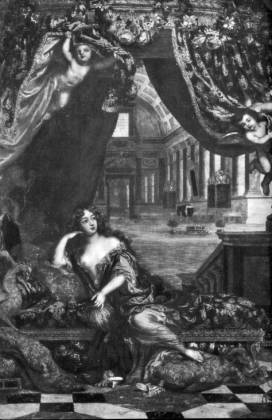
Marquise de Montespan, mistress to Louis XIV
The sexual mores of Racine's sphere were rife with contradiction at the time of Phèdre's premiere in 1677. On the one hand, infidelity in the upper registers of society was so commonplace as to be nearly unremarkable, and the political and social power of mistresses was all but unchecked.
Voltaire said of Louis XIV, "Louis liked the ladies, and it was reciprocal." The king gave himself a constant entourage of beautiful women who traveled with him in his carriage, played cards with him, danced with him, and sometimes shared his bed. On the other hand, the rules governing the exact hierarchy of mistresses were stringent, and the considerations of dynasty and inheritance together with the pressures of religion further tightened the reins.
According to historian Richard Lewinsohn, the women with whom a prince or high-ranking noble had sexual relations fell into three strictly defined categories: consorts, lovers, and partners in pleasure. The consort had to come from a ruling House, or a House that had once enjoyed that status. Only children of such a union were entitled to succession. The second place in the sex-hierarchy was occupied by the maitresse-en-titre, or favorite, who was the official extramarital lover.
The standing of the maitresse-en-titre in social life was a very high one; in political life it was often unrivalled. The children of such unions were given high titles of nobility, and the lover's remoter kinsfolk were given comfortable appointments and imposing labels. European Courts in this age swarmed with marquesses, counts, princes and dukes who owed their high-sounding names and their estates to the sexual needs of the ruling monarch.
At the same time, even the most powerful mistresses were entirely dependent on the whims of the ruler. They enjoyed no legal security, and might fall out of favor from one day to the next and be cast out of the Court circle. (Indeed, it was one such mistress, de Montespan, who pushed for Racine's commission as official historiographer to the monarch. A handful of years later, Racine would turn on the woman, writing the play Esther, a vehicle which featured Louis' rising favorite - and eventual second wife - de Maintenon in a starring role and included de Montespan in the cast largely for the purpose of publicly humiliating her.) The relationship with a favorite usually lasted several years and took on the form of normal married life, until the mistress was discarded, often to finish out her days in a convent.
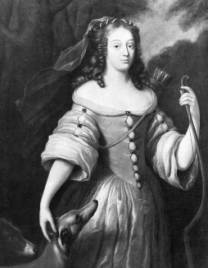
Louise de la Valliere, mistress to Louis XIV, portrayed as the goddess Diana
Very far behind the official wives and great mistresses came a third category of women, the recipients of a prince's occasional attentions: enjoyed for a night, or at most for a few weeks, their function was simply that of any courtesan. They were admitted by discreet back doors into the royal bedchamber, or into some special pavilion where the prince amused himself unbeknown to his wife or - what was more important still - to his maitresse-en-titre. As time went on, this third category came to be drawn increasingly from ladies of the stage-- actresses, singers, and dancers.
Often, Louis and his throng of companions took part in decadent ballets d'entrées, elaborate allegorical entertainments composed of spoken libretti and movement based on ballroom dances. The king first earned his nickname as the "Sun King" for dancing the role of Apollo in a ballet called The Ballet of the Night. The ballets were an opportunity for Louis' courtiers to lavish praise on the king and his pretty flock, and surviving letters and reviews remark on the performers' "incredible agility and grace," "unbelievable beauty," "touching grace," and every other imaginable combination of flattering epithets.
According to biographer Oliver Bernier, these elaborate formal spectacles contained more than a hint of less-than-speakable urges below their gilded surface, in part due to the fact that some of the participants were not always of flawless repute. Because roles were awarded based not on social status but on technical proficiency, low-ranking nobles and members of subordinate classes danced alongside the royals and their friends. Professional female dancers appeared alongside noblemen, and sometimes opposite the king himself. However, the formal nature of ballet could not whitewash all moral distinctions: it was still considered unsuitable for well-bred ladies to appear with professional male dancers, so the women danced only with men of their own caste.
As an answer to why the king suddenly stopped dancing in these sensuality-tinged demonstrations in 1669, while only 31 years old and still quite physically capable of impressive displays, one may look to Jean Racine. Racine's Brittanicus contains lines that show the Romans' disdain for the fact that their emperor plays roles in the theatre, and several biographers have pointed to this veiled commentary on Louis as the reason for the king's sudden distaste for pirouettes.
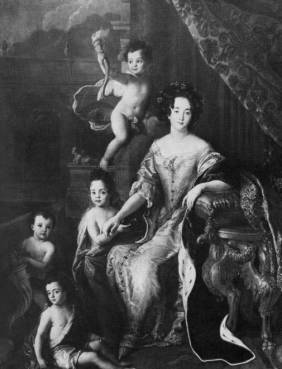
The Marquise de Montespan, pictured here with four of the children she had by Louis XIV.
In the midst of such excesses, the serious Racine called Venus "the goddess of love and death." The writer's progressively more strict Jansenist beliefs (see Dramaturgy Part 2) stood in sharp contrast to courtly doings. Scholar John Cairncross confirms that "the Jansenists disliked Louis' policies, and even more his love of pleasure, women, and fetes, including theatrical performances; and their dislike was heartily reciprocated."
Part of Racine's courtly role seemed to be as a voice of gentle dissent from the melee, and in her History of European Drama, Erika Fischer-Lichte describes the playwright's work as "in striking opposition to the views and persuasions on which court life was founded." Louis encouraged this, especially as he himself became more pious with age. After one flattering speech, the monarch told Racine: "I would praise it more if you had praised me less."
(For more on the sexual protocols of this world, see the excerpt from the Duc de Saint-Simon's Memoirs in Dramaturgy Part 5.)
Dramaturgy Part 4: Geography and Genealogy
(This is part 4 of a package of dramaturgical material for Phèdre, written, collected and edited by Megan Cohen and Michael Paller of the American Conservatory Theater.)
Trezene (or Troezen) was a city in southern Greece. Athens was the great capital city of the realm, and Crete was a large and powerful island to the south.

Detail map showing Troezen and Athens:

Aethra was the princess of Trezene, and Aegeus was king of Athens; Theseus was their son and heir to both thrones. (Some myths say that on the night of Theseus' conception, Aethra also lay with the god Poseidon, making her child semi-divine.)
When Theseus wed Phèdre, King Minos' daughter and therefore princess of Crete, the three kingdoms were consolidated under Theseus' reign. According to Bulfinch's Mythology, Theseus was a semi-historical figure famed for uniting many city-states under his banner. (For more, see the chapters "Theseus" in Edith Hamilton's Mythology, and "Minos and His Brothers" in Robert Graves's The Greek Myths.)
Pandion, an earlier ruler of Athens, made Aegeus his adopted son and heir. Pandion's biological son, Pallas, was Aricie's father, which could give her a rightful claim on the Athenian throne.
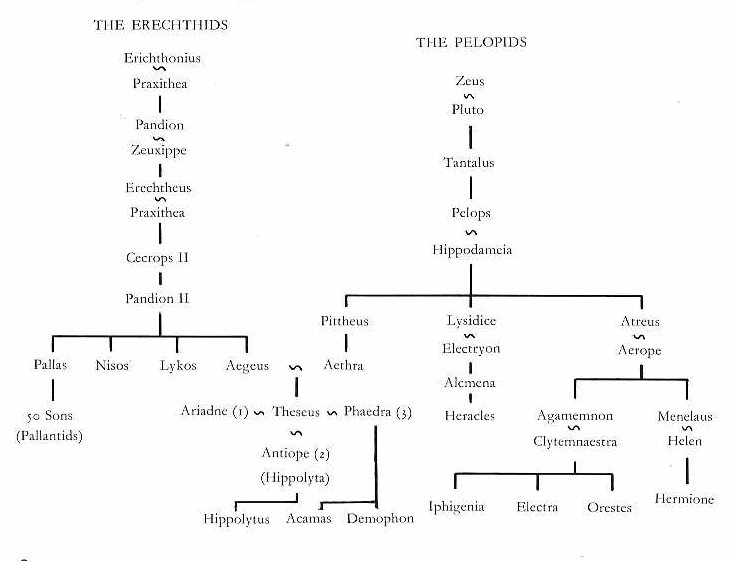
Dramaturgy Part 5: Bibliography
This is the final part of a package of dramaturgical material for Phèdre, written, collected and edited by Megan Cohen and Michael Paller of the American Conservatory Theater.
Barthes, Roland. Trans. Richard Howard. On Racine. University of California Press, 1964.
Bernier, Oliver. Louis XIV: a Royal Life. Doubleday, 1987.
Bulfinch, Thomas. Bulfinch's Mythology: Illustrated Edition. Gramercy Books, 1979.
Brockett, Oscar. History of the Theatre: Sixth Edition. Allyn and Bacon, 1991.
Fischer-Lichte, Erika. History of European Drama. Routledge, 2002.
Graves, Robert. The Greek Myths. New York: Penguin, 1955.
Hamilton, Edith. Mythology. Little, Brown and Company, 1942.
Hatton, Ragnhild. Louis XIV and his World. G.P. Putnam's Sons, 1972.
Hollier, Dennis, ed. A New History of French Literature. Harvard University Press, 2004.
http://www.britannica.com/EBchecked/topic/266676/Hippolytus
"Hippolytus." Encyclopaedia Britannica. 2009. Encyclopaedia Britanica Online. 20 Apr. 2009 http://www.britannica.com/Ebchecked/topic/266676/Hippolytus
Lewinsohn, Richard. Trans. Alexander Mayce. A History of Sexual Customs. Harper and Brothers, 1958.
Mitford, Nancy. The Sun King. Harper & Row, 1966.
Racine, Jean, trans. John Cairncross. Iphigenia/Phaedra/Athaliah. Penguin, 1970.
Saint-Simon, trans. Bayle St. John. Memoirs. Chatto and Windus, 1876.
Strachey, Lytton. Books and Characters in French and English. Harcourt, Brace and Company, 1922.
"Troezen." Encyclopedia of Greek Mythology. 9 Jun. 2009 http://www.mythweb.com/Encyc/entries/troezen.html
Wallace, Jennifer. The Cambridge Introduction to Tragedy. Cambridge University Press, 2007.
Wolf, John B. Louis XIV. Norton and Company, 1974.
